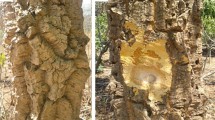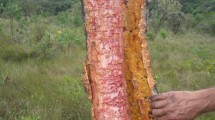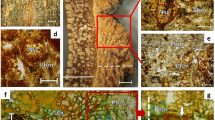Abstract
The chemical composition and cellular structure of corks from cork oak (Quercus suber) trees grown in Bulgaria and Turkey were studied for the first time to gain insight into the quality of cork from areas external to the species natural distribution. The cellular structural arrangement of Bulgarian and Turkish corks was similar to Portuguese cork, but chemical composition differed significantly. In general, Bulgarian and Turkish corks contained higher amount of ash and lignin and lower amount of extractives than Portuguese cork. Bulgarian cork contained less suberin and more polysaccharides than Turkish and Portuguese corks. The differences in the suberin/lignin ratio (1.4, 1.1 and 2.0 in corks from Bulgaria, Turkey and Portugal, respectively) suggest differences in mechanical behavior, namely in compression. Suberin composition was similar in all corks, but differences in relative proportion of families and compounds were present, indicating natural variation related to cork origin. Lipophilic extractives differed between corks: Betulinic acid was the main triterpene in Bulgarian cork, while friedelin dominated the lipophilic extractives in Portuguese and Turkish corks. A new lupane-type pentacyclic triterpene was found in Bulgarian and Turkish corks.

Similar content being viewed by others
References
Blanch GP, Villen J, Herraiz M (1998) Rapid analysis of free erythrodiol and uvaol in olive oils by coupled reverse-phase liquid chromatography-Gas chromatography. J Agric Food Chem 46:1027–1030
Castola V, Marongiu B, Bighelli A, Floris C, Laï A, Casanova J (2005) Extractives of cork (Quercus suber L.): chemical composition of dichloromethane and supercritical CO2 extracts. Ind Crop Prod 21:65–69
De la Puerta R, Martinez-Dominguez E, Ruiz-Gutierrez V (2000) Effect of minor components of virgin olive oil on topical antiinflammatory assays. Z Naturforsch C 55:814–819
Domingues RMA, Sousa GDA, Silva CM, Freire CSR, Silvestre AJD, Neto CP (2011) High value triterpenic compounds from the outer barks of several Eucalyptus species cultivated in Brazil and in Portugal. Ind Crop Prod 33:158–164
Eglinton G, Hunneman DH (1968) Gas chromatographic-mass spectrometric studies of long chain hydroxy acids-I: the constituent cutin acids of apple cuticle. Phytochemistry 7:313–322
Ekman R (1983) The Suberin Monomers and Triterpenoids from the Outer Bark of Betula verrucosa Ehrh. Holzforschung 37:205–211
Ferreira JPA, Miranda I, Gominho J, Pereira H (2015a) Selective fractioning of Pseudotsuga menziesii bark and chemical characterization in view of an integrated valorization. Ind Crop Prod 74:998–1007
Ferreira JPA, Miranda I, Gominho J, Pereira H (2015b) Chemical characterization of cork and phloem from Douglas fir outer bark. Holzforschung 70:475–483
Graça J, Pereira H (1997) Cork suberin: a glyceryl-based polyester. Holzforschung 51:225–234
Graça J, Pereira H (2000) Methanolysis of bark suberins: analysis of glycerol and acid monomers. Phytochem Anal 11:45–51
Jäger S, Laszczyk MN, Scheffler A (2008) A preliminary pharmacokinetic study of betulin, the main pentacyclic triterpene from extract of outer bark of birch (Betulae alba cortex). Molecules 13:3224–3235
Juan ME, Wenzel U, Daniel H, Planas JM (2008) Resveratrol induces apoptosis through ROS-dependent mitochondria pathway in HT-29 human colorectal carcinoma cells. J Agric Food Chem 56:4813–4818
Kayacık H, ve Eliçin G (1965) Bahçeköy’de Orman Fakültesi Tatbikat Sahasında Mantar Meşesi (Quercus suber L.) Denemesinden Bugüne Kadar Elde Edilen Sonuçlar. İ.Ü. Orman Fakültesi Dergisi, Seri A, 15:23–31 English edition: Results of the establishment of cork oak (Q. suber L.) plantations in the experimental field of Faculty of Forestry, Bahcekoy, Istanbul. J Fac For Istanbul Univ A, 15:23–31
Knapp DR (1979) Handbook of Analytical Derivatization Reactions. John Wiley & Sons, New York
Kolattukudy P, Agrawal V (1974) Structure and composition of aliphatic constituents of potato tuber skin (suberin). Lipids 9:682–691
Kozlowski TT, Pallardy SG (1997) Growth control in woody plants. Academic Press, San Diego
Marques AV, Rencoret J, Gutiérrez A, del Rio JC, Pereira H (2015) Ferulates and lignin structural composition in cork. Holzforschung. doi:10.1515/hf-2015-0014
Marquez-Martin A, De la Puerta R, Frenandez-Arche A, Ruiz-Gutierrez V (2006) Supressive effect of maslinic acid from pomace olive oil on oxidative stress and cytokine production in stimulated murine macrophages. Free Radic Res 40:295–302
Martín R, Ibeas E, Carvalho-Tavares J, Hernández M, Ruiz-Gutierrez V, Nieto ML (2009) Natural triterpenic diols promote apoptosis in astrocytoma cells through ROS-mediated mitochondrial depolarization and JNK activation. PLoS One 4:e5975
Miranda I, Gominho J, Pereira H (2013) Cellular structure and chemical composition of cork from the Chinese cork oak (Quercus variabilis). J Wood Sci 59:1–9
Moure A, Cruz JM, Franco D, Domínguez JM, Sineiro F, Domínguez H, Núñez MJ, Parajó JC (2001) Natural antioxidants from residual sources. Food Chem 72:145–171
Neyisçi T, Yesilkaya Y, Usta Z (1987) Akdeniz bolgesinde Mantar Mesesi (Quercus suber L.) yetistirilmesi olaklarinin arastirilmasi (Studies on the introduction of cork oak (Quercus suber L.) to the Mediterranean region of Turkey). Ormancilik Arastirma Enstitusu Yayinlari, Teknik bulten serisi no 193 (in Turkish) English edition: Cork oak in the Mediterranean region (Quercus suber L.) cultivated the Investigation of Colak (Studies on the introduction of cork oak (Quercus suber L.) to the Mediterranean region of Turkey) Forest Research Institute Publications, Technical bulten Series No 193
Oliveira V, Rosa ME, Pereira H (2014) Variability of the compression properties of cork. Wood Sci Technol 48:937–948
Olivella MA, del Rio JC (2011) Suberin composition from different bark layers of Quercus suber L. by Py-GC/MS in the presence of tetramethylammoniumhydroxide (TMAH). Bioresources 6:4936–4941
Pereira H (1988a) Structure and chemical composition of cork from Calotropis procera (AIT.) R. BR. IAWA J 9:53–58
Pereira H (1988b) Chemical composition and variability of cork from Quercus suber L. Wood Sci Technol 22:211–218
Pereira H (1992) The thermochemical degradation of cork. Wood Sci Technol 26:259–269
Pereira H (2007) Cork: biology, production and uses. Elsevier Press, London
Pereira H (2013) Variability of the chemical composition of cork. BioResources 8:2246–2256
Pereira H (2015) The rationale behind cork properties: a review of structure and chemistry. BioResources 10:6207–6229
Pereira H, Rosa ME, Fortes MA (1987) The cellular structure of cork from Quercus suber L. IAWA Bull 8:213–218
Petrov M (1994) The cork oak and its propagation in Bulgaria. BAS Publisher Marin Drinov, Sofia, pp 1–210 (in Bulgarian, English summary)
Petrov M, Genov K (2004) 50 Years of cork oak (Quercus suber L.) in Bulgaria. Nauka za Gorata (For Sci) 3:93–101
Rios P, Cabral V, Santos S, Mori F, Graça J (2014) The chemistry of Kielmeyera coriacea outer bark: a potential source for cork. Eur J Wood Prod 72:509–519
Rodriguez-Rodriguez R, Simonsen U (2012) Natural triterpenoids from olive oil: potential activities against cancer. In: Diederich M, Noworyta K (eds) Natural compounds as inducers of cell death. Springer, New York, pp 447–461
Sen A, Miranda I, Santos S, Graça J, Pereira H (2010) The chemical composition of cork and phloem in the rhytidome of Quercus cerris bark. Ind Crop Prod 31:417–422
Sen A, van den Bulcke J, Defoirdt N, van Acker JV, Pereira H (2014) Thermal behavior of cork and cork components. Thermochim Acta 582:94–100
Sen A, Melo MMR, Silvestre AJD, Pereira H, Silva CM (2015) Prospective pathway for a green and enhanced friedelin production through supercritical fluid extraction of Quercus cerris cork. J Supercrit Fluids 97:247–255
Sousa AF, Pinto PCRO, Silvestre AJD, Neto CP (2006) Triterpenic and other lipophilic compounds from industrial cork byproducts. J Agric Food Chem 54:6888–6893
TAPPI 13 wd-74 (TAPPI 13 os-54 combined with TAPPI 222 om-11). Lignin in wood. http://www.tappi.org/content/pdf/standards/numeric_index_tms.pdf. Accessed 21 Apr 2016
TAPPI 249 cm-09. Carbohydrate composition of extractive-free wood and wood pulp by gas-liquid chromatography. http://www.tappi.org/content/pdf/standards/numeric_index_tms.pdf. Accessed 22 Mar 2016
TAPPI T 15 os-58. Ash in wood. http://www.tappi.org/content/pdf/standards/numeric_index_tms.pdf. Accessed 4 Apr 2016
Wandji J, Tillequin F, Mulholland DA, Wansi JD, Fomum TZ, Fuendjiep V, Libot F, Tsabang N (2002) Fatty acid esters of triterpenoids and steroid glycosides from Gambeya Africana. Planta Med 68:822–826
Acknowledgments
The first author acknowledges a postdoctoral fellowship from the FCT (Fundação para a Ciência e a Tecnologia) Portugal. Centro de Estudos Florestais (CEF) is a research unit supported by the national funding of FCT (PEst-OE/AGR/UI0239/2014). Thanks are due to Dens and Pavlo for their help in the samplings in Bulgaria.
Author information
Authors and Affiliations
Corresponding author
Rights and permissions
About this article
Cite this article
Sen, A., Zhianski, M., Glushkova, M. et al. Chemical composition and cellular structure of corks from Quercus suber trees planted in Bulgaria and Turkey. Wood Sci Technol 50, 1261–1276 (2016). https://doi.org/10.1007/s00226-016-0836-y
Received:
Published:
Issue Date:
DOI: https://doi.org/10.1007/s00226-016-0836-y




